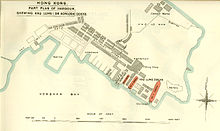Hong Kong and Whampoa Dock
This article needs additional citations for verification. (January 2018) |



Hong Kong and Whampoa Dock was a Hong Kong dockyard, once among the largest in Asia.
History[edit]
Founded in 1866 by Douglas Lapraik and Thomas Sutherland,[1] the Hong Kong and Whampoa Dock Company (known as Hong Kong Kowloon and Whampoa Dock Company). In 1865, it was known as Kowloon Docks and located on the west Kowloon coast between Hung Hom and Tai Wan, facing Hung Hom Bay in the Victoria Harbour. It is also known as Whampoa Dock for short. The "Whampoa" part of the name comes from the harbor located at was then known as Huangpu Island (previously transliterated as Whampoa), adjacent to the city of Guangzhou (previously transliterated as Canton), where the company owned another dockyard.
On the eve of Japanese occupation of Hong Kong, the dockyard was heavily bombarded by Japanese aircraft due to its importance, causing many casualties.
In the mid-1960s, the Hong Kong and Whampoa Dock Company was controlled by Douglas Clague through Hutchison International but he was forced to leave following financial difficulties with Hutchison International. Hutchison International was acquired by Li Ka Shing's Cheung Kong Holdings and eventually merged with Whampoa to become Hutchison Whampoa. In 1985, the dockyard land was transformed into a private housing estate, the Whampoa Garden, the second-largest private housing estate in Hong Kong, after Mei Foo Sun Chuen. The only portion of the dockyard that exists is Bulkeley Street.[citation needed] The dockyard is now part of the Whampoa Garden site residential complex.
The dockyard operations merged with Swire's Taikoo Dockyard on the Island to become Hongkong United Dockyards on the new territories western shore of Tsing Yi Island Wok Tai Wan.
Hong Kong and Whampoa Dock helped converted Hong Kong Tramways second and third generation tram cars built by United Electric and English Electric. These cars were eventually retired from 1924 to 1930 as the fourth-generation cars were introduced.
Other facilities:
- Hope Dry Dock in Aberdeen, opened 1867.
Ships[edit]
Ships built at this yard include:
- Leyte (1887) gunboat with Spanish and later USN gunboat.
- Manok (1930) Built for La Naviera Filipina, Inc., Cebu, Philippine Islands. Capsized and sank between Silinog and Aliguay Islands off Dapitan, and Apo Island off Dumaguete on Aug 5, 1941.
- Foo-mun-tsai (1881); Built for the Qing government's Canton Customs Authority.[2]
- USS Mariveles (1886)
- Con-rong (1887); French steamer.[2]
- Mellong (1901); Steamer built for German company Norddeutscher Lloyd for river use around Bangkok.[2]
- Fathomer (1904)
- USS San Felipe (YFB-12) (1907)
- USS Banaag (YT-104) (1910)
- Kwai Sang (1917)
- S.S. Suddhadib 1918 (Maiden voyage; Hong Kong 22 April 1918)Built for the Siam Steam Navigation Company (part of the East Asiatic Company (EAC) - Bangkok-based, Danish owner) Shipwrecked: 01-06-1945 Allied Bombing - Siam Bay.
- S.S. Valaya 1918 sistership to s.s.Suddhadib above.(Maiden voyage; Hong Kong June 15th )Built for the Siam Steam Navigation Company (part of the East Asiatic Company (EAC) - Bangkok-based, Danish owner) Shipwrecked: 13 Jan 1944(sunk by mines in the mouth of Chaopraya River 1944)
- War Bomber (1919); 5,226 ton (8,000 ton deadweight), 400 foot warship, largest ship to date built at the Kowloon Docks for Shipping Controller, London. Later, would come into Japanese service during WWII and be sunk on 4 September 1942 as Kaimei Maru.[2][3]
- War Trooper (1919); 8,000 ton (deadweight), 400 foot warship, sister ship of the War Bomber.[2]Later entered Greek service as Ambatielos, returning to British service in 1923 as King Gruffydd. In 1939, pressed into Admiralty service as HMS Maunder (X-28), torpedoed and sunk in 1943.[4][5]
- SS Changte (1925) for Australian Oriental Line; later became Royal Navy Naval Stores Issuing Ship RFA Y1-9.[6]
- Sang Wo (1926)
- SS Taiping (1926) for Australian Oriental Line[6]
- USS YAG-3 (1926)
- SS Prince Narisra 1929. Yard no. 336. Siam Steamship Navigation Company, Bangkok. Damaged during bombing 1945 in Bangkok. Scrapped 1949 BKK
- USS YAG-4 (1931)
- Li Wo (1938); 1,000 ton passenger ship later converted as a patrol vessel for the Royal Navy; sank near Singapore in 1942 as HMS Li Wo.[7]
- HMAS Matafele (1938)
- Ranger (1940), ocean-going tugboat
- SS Empire Moonbeam[8]
- SS Empire Almond (1941)
- SS Gyōkū Maru (1942)
- and many of the Hong Kong Star Ferry vessels in service today.
See also[edit]
References[edit]
- ^ Swiggum, S. (2013). "Douglas Steamship Company, Ltd". theshipslist.com. Retrieved 10 June 2013.
- ^ a b c d e "A brief history of the Hong Kong dockyards". mardep.gov.hk. Hong Kong Marine Department. 2019. Retrieved 20 August 2019.
- ^ Hackett, Robert (2019). "KAIMEI MARU: Tabular Record of Movement". combinedfleet.com. Robert Hackett. Retrieved 21 August 2019.
- ^ "King Gruffydd". bandcstaffregister.com. The British and Commonwealth Register. 2019. Retrieved 22 August 2019.
- ^ C. J. Greenwood (1994). International Law Reports: Volume 23. London: Cambridge University Press. pp. 330–334. ISBN 0521463688.
- ^ a b Wildy, Merv (14 July 2003). "Allied Chinese Ships WWII". Archived from the original on 28 October 2003. Retrieved 24 October 2010.
- ^ "The story of HMS Li Wo and her crew". forcez-survivors.org.uk. 2012. Retrieved 10 June 2013.
- ^ "Empire Moonbeam". uboat.net. Retrieved 9 February 2023.
- Hung Hom
- Dockyards in Hong Kong
- Former companies in the Hang Seng Index
- Predecessors of CK Hutchison Holdings
- Shipbuilding companies of Hong Kong
- Companies formerly listed on the Hong Kong Stock Exchange
- Former buildings and structures in Hong Kong
- Ships built by the Hong Kong & Whampoa Dock Company
- Water transport stubs
- Asian history stubs
- Hong Kong stubs
- Kowloon stubs

